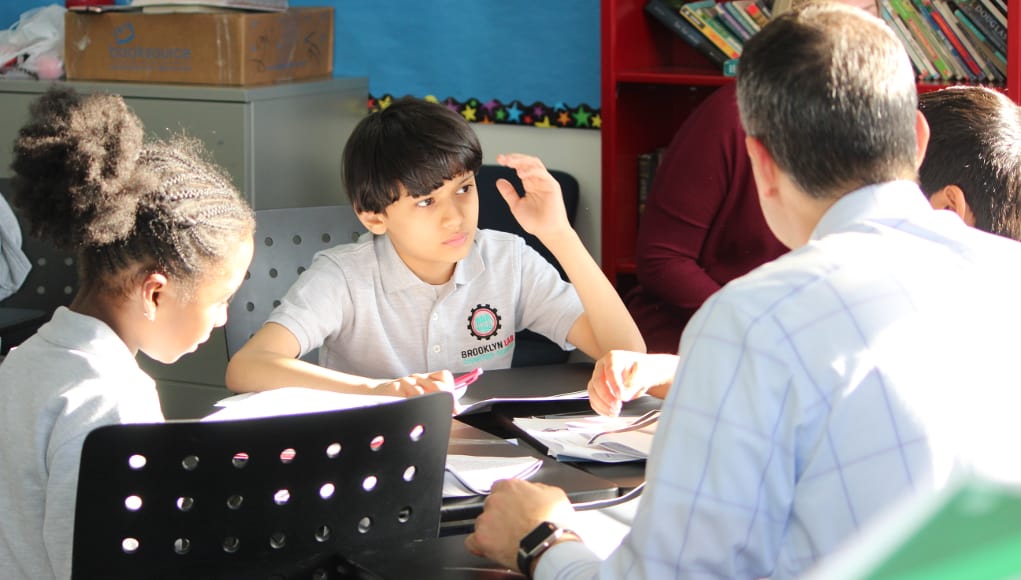Getting Smart Podcast | America’s Edu Power Couple On Balancing Innovation and Execution

Eric Tucker has a doctorate in measurement from Oxford and spent most of a decade building a 450 school urban debate league. He designed schools for leading networks and built programs for the Federal Reserve.
Erin Mote is a technologist skilled in user-centered, agile design. She led projects for USAID (like getting Haiti back online after the 2010 earthquake), Department of State, FCC and the White House.
Tucker and Mote co-founded Brooklyn Laboratory Charter School (LAB) which “prepares students with the academic foundation, digital literacy and leadership skills necessary to excel in college and professional life as they grow as ethical leaders.”
Listen as this dynamic duo share more about building a durable yet flexible future-ready school and creating a new learning platform, all while parenting a toddler.
Podcast Highlights
LAB combines high dose tutoring–at least two hours of an extended day–with personalized and enriched learning (e.g., Robotics, Digital Media, Coding, Debate, Visual Arts).
Launched with 132 sixth graders in 2014, LAB finished the 2016-17 year with two middle schools in downtown Brooklyn and will open a high school in the fall.
Almost 40 percent of Brooklyn LAB middle school students have complex needs. A combination of classroom instruction, digital playlists and small group tutoring reflect individual student interests and needs.
The schools are built on the idea that the jobs students will one day hold likely don’t exist yet, but mastering skills such as problem-solving and conflict resolution will ensure students are ready to tackle those challenges, regardless of their career path.
The innovative high school was designed with a Next Generation Learning Challenges grant (and is a great example of a network focused on the NGLC MyWays outcome framework) and was one of 10 schools to win a $10 million XQ grant.
Video courtesy of USAToday.com
Getting The Design Right
Eric directs Brooklyn LAB and Erin leads platform partner, InnovateEDU. They set out to build a public institution that would last but that was also nimble enough to change quickly.
Their two-part impact strategy is a managed network of schools with proof-point performance–schools that demonstrate what is possible working with high challenge, complex need student populations. And second, a platform network–hundreds of schools innovating and learning from each other on a personalized learning platform.
The LAB model embraces adolescent voice and acknowledges that learning happens in context and is ultimately preparation for the future. “There is a lot of uncertainty about what the world will demand of our [young students] thirty and forty years from now,” Tucker said. “Because we are unclear of which skills are needed and which experiences are valuable, and how students need to play a role in generating opportunities to learn, it’s critical to think both about what curriculum, assessment and instructional moves matter from adults, but ultimately also about how students can make sense of opportunities to learn.”
Borrowing lessons from software development, the LAB high school was designed through a user-centered, agile process informed by students, parents and stakeholders.
In the first phase, a transformation team captured user stories to define the Why (values, purpose, principles) and How (behavior, language, roles, tasks).
In phase two, the design is enacted through pilots and testing. Lots of conversations help recognize what’s what working and what’s not.
Phase three is an ongoing operation with distributed leadership and a focus on failing fast and short cycle innovation. It’s important to remain open to feedback to keep the design dynamic.
Platform Lessons
When planning the first LAB middle school, Erin reviewed existing learning platforms and wasn’t satisfied with what she found. Despite advice to the contrary (from people like me) Erin decided to build a learning platform.
Cortex is an integrated student information system and learning management system that supports personalized learning progressions. It supports and tracks mastery development against state standards.
The beta version of Cortex had what Erin thought was a beautiful workflow management system. But teachers hated it. Iterative cycles with frequent user feedback was key to developing a platform that provides teachers more time to facilitate relationships.
Cortex is an Ed-Fi operational data store that gathers information around students’ learning experiences. The instructional layer allows teachers to deploy plans and playlists based on learner profiles. Cortex gathers real-time assessment data to facilitate personalized learning. (see case study).
Aligning A School Model And Platform
Only a handful of school networks have had the opportunity (or been brave and skilled enough) to develop a learning platform fully aligned with a learning model.
“They way we built Cortex supports other personalized learning models,” said Mote. The team has tried to identify 75 percent consistency between personalized models while supporting the 25 percent experimental variables. Her team is shipping version 4.0 this month (July) with the goals of “adding rocket fuel to innovative designs.”
“Brooklyn LAB committed to Cortex because we want to move to a learning-based system,” said Tucker.
Unlike Summit Learning, this is not a replication effort. “There’s going to be a lot of potential solutions, and we look forward to sharing work with other schools,” said Tucker. He hopes that Cortex users will solve problems and share solutions across the network.
Mote said the LAB and Cortex teams have a shared vision of shifting the locus of control and allowing students to manage their own learning
“Intellectual work is really important,” said Mote. Cortex supports teacher teams designing challenging intellectual experiences by sharing, mixing and curating.
After 65 end-of-year events in June, the LAB leadership team focuses on building adult capacity for September. There are a set of evergreen goals around what the team wants to accomplish. “Then there are a set of big rocks we need to tackle together,” said Tucker. “Moving big rocks is team sport.” Tucker limits the vectors of innovations to retain role and goal clarity.
Cortex powers new schools in the Achievement First network and has a statewide relationship in Rhode Island. Erin is excited about the growth in San Antonio and powering Alabama’s first charter school. “We design for widest use but are informed by Brooklyn LAB,” said Mote.
Interoperability is key to leveraging a diverse network. Erin is leading a Dell Foundation sponsored initiative, Project Unicorn, to promote better access to and interoperability between different sources of student achievement data.
Working In Networks
“Networks make us smarter,” said Mote. “Like Yelp, the number of users [on a learning platform] matters.”
Mote would like to join like-minded schools together and “build learning ecosystems of induction, creation and collaboration.”
“School leaders are asking themselves how to prepare young people for an uncertain future,” said Tucker. “Students need to code, tinker, hack and make.”
With lots of schools on the platform, Cortex may become a bit less nimble, but it will become part of a broader connected conversation. Erin is encouraging users to make content available across the platform so that anyone in the Cortex community can pull down a course.
“We have an opportunity to have a community join together to make the charging stations that power learning–schools, youth-serving institutions, tech startups–all working together to create a credible pathway to postsecondary success.”
This blog is part of a multi-year campaign studying networks and their effect on education and transformation. Our work will culminate in a book publishing in 2018. Learn more and join the conversation using #NetworkEffect.
For more, see:
- How to Create Experiences and Scale Environments That Change Lives
- How School Networks Work and Why That’s Important
- Structures Drive Behaviors: Right is Magic Wrong is Deadly










0 Comments
Leave a Comment
Your email address will not be published. All fields are required.